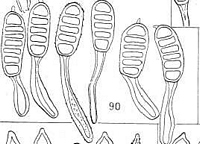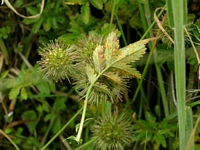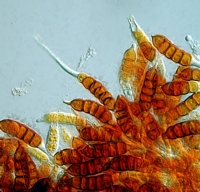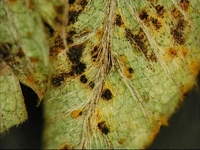|
 Phragmidium subsimile Phragmidium subsimile
BiostatusPresent in region - Indigenous. Endemic
Images (click to enlarge)
Caption: FIG. 90. Phragmidium subsimile G.H. Cunn. Teleutospores from Acaena Sanguisorbae
Vahl. var. pilosa T. Kirk. | 
Owner: J.A. Cooper | 
Caption: telia
Owner: J.A. Cooper | 
Caption: uredinia and telia on undersurface of leaf
Owner: J.A. Cooper | |
Article: Cunningham, G.H. (1924). The Uredinales, or rust-fungi, of New Zealand: supplement to Part 1; and Part 2. Transactions and Proceedings of the New Zealand Institute 55: 1-58 Wellington:.
Description: 0. Spermogones hypophyllous, sparse, scattered, pallid yellow.
I. Caeomata hypophyllous, sparse, scattered, orbicular, 0.5-3 mm. diam., pulverulent, orange;
encircled by a dense layer of hyaline, clavate, incurved, persistent paraphyses. Spores
subglobose, 18-22 mmm.; epispore hyaline, densely and closely verrucose, 1.5-2 mmm. thick,
cell-contents vacuolate, orange.
III. Teleutosori hypophyllous, scattered, elliptical, up to 2 mm. long, pulverulent,
greyish-black, containing very many
spores in each sorus. Spores 5-7-celled, commonly 6, oblong-terete, 57-70 X 22-30 mmm.; apex rounded,
not thickened, often crowned with a prominent,
tinted, smooth papilla, not continuous with the upper cell-wall, up to 10 mmm. long, base
rounded, spore markedly narrowed above and below; not constricted at the septa; wall
chestnut-brown, 3-5 mmm. thick, sparsely and coarsely warted, warts hyaline, unequally
distributed; pedicel persistent, continuous with the spore, tinted above, hyaline below, stout,
up to 100 mmm. long, 6-10 mmm. thick, hollow, swollen to 18 mmm. at base, lower half
closely and minutely verruculose; germ-pores 2-3 in each cell, obscure.
Notes: The host species A. Sanguisorbae is indigenous and widespread; it occurs also in Australia,
Tasmania, and Tristan d'Acunha; the variety pilosa is endemic, and is not uncommon.
(Cheeseman, 1906, p. 131.)
This species somewhat resembles Phr. Sanguisorbae Schroet. (fig. 91), but differs in the
differently-shaped, broader teleutospores, in there being 5-7 cells in the spore instead of 2-5,
and in the much longer pedicels. The teleutosorus characters, too, are quite different.
This species serves as a connecting-link between Phr. Acaenae and Phr. Sanguisorbae; and,
of the New Zealand species, one would imagine the ancestral form to have been of the Phr.
Sanguisorbae type, from which arose in succession Phr. subsimile, Phr. Acaenae, and
finally Phr. novae-zelandiae. Phr. Potentillae, on the other hand, would appear to have
arisen from a different form, as it has not the same general resemblance to the three species
discussed above. Dr. Cockayne informs me that the hosts readily hybridize; and that the so-called species A. Sanguisorbae is in
reality a composite species. This would partly account
for the fact that on this species as many as three species of Phragmidium occur, whereas on
other well-defined host species, and even varieties, one rust only is found.
I am indebted to Dr. Grove for specimens of Phr.Sanguisorbae, from which fig. 91 has been
drawn.
Article: Dingley, J.M. (1969). Records of plant diseases in New Zealand. New Zealand Department of Scientific and Industrial Research, Bulletin 192: 298 p. Wellington:.
Notes: Records show this rust to occur only in Wellington Province in the North Island but to be common
throughout the South Island. It is an indigenous rust species occurring only on indigenous host
species [Acaena spp.].
|